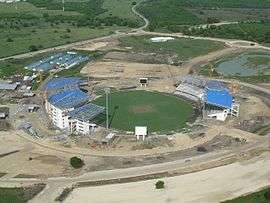Sir Vivian Richards Stadium
|
The stadium during construction in October 2006 | |
| Ground information | |
|---|---|
| Location | North Sound, Antigua, Antigua and Barbuda |
| Establishment | 2006 |
| Capacity | 10,000 |
| End names | |
|
Andy Roberts End Curtly Ambrose End | |
| International information | |
| First Test |
30 May–3 June 2008: |
| Last Test |
21–25 July 2016: |
| First ODI |
27 March 2007: |
| Last ODI |
5 March 2014: |
| First T20I |
19 May 2010: |
| Last T20I |
3 March 2013: |
|
As of 21 July 2016 Source: CricketArchive | |
Sir Vivian Richards Stadium is a stadium in North Sound, Antigua, Antigua and Barbuda. It was built for use in the 2007 Cricket World Cup where it hosted Super 8 matches. The stadium usually caters for 10,000 people, but temporary seating doubled its capacity for the 2007 World Cup. The stadium is named after former West Indies cricket captain Viv Richards.
The stadium is about 10–20 minutes' drive from the capital city, St. John's, and the country's international airport. The venue cost approximately US$60 million to build, with the majority of the funds coming from a Chinese Government grant.[1] The first Test match staged on the ground began on 30 May 2008 when the West Indies hosted Australia, with the match ending in a draw.
The stadium constitutes two main stands: the Northern Stand and the five story South Stand. In 2008, the roof of the South Stand was damaged by high winds.[2] Other facilities include a practice pitch for the various cricket teams, training infrastructure and a media centre. Sir Viv Richards Stadium is one of the few state-of-the-art venues that encompass underground passageways for the cricket teams to move about in.[3][4]
Prior to the start of the first Test against England on 13 April 2015, the north and south ends were renamed for two former West Indies cricketers, Sir Curtly Ambrose and Sir Andy Roberts.
Outfield controversy
The ground's second Test match began against England on 13 February 2009. However, the match was abandoned after only ten balls due to the outfield's dangerous condition. The groundstaff had applied an extra layer of sand after recent flooding, which resulted in the bowlers being unable to gain a foothold when running in.[5] The sandy nature of the outfield earnt the ground the nickname of 'Antigua's 366th beach' in the buildup to the game.[6] The abandonment caused great embarrassment for West Indies cricket, with inquests held by the WICB and the ICC. The ICC inquest resulted in the ground being suspended from staging all international matches for twelve months and an official warning was issued to the WICB.
See also
References
- ↑ "Pitch Report – Sir Vivian Richards Stadium". Retrieved 2009-02-14.
- ↑ "Stolen goods, missing ladies and a flying roof". Retrieved 2009-02-14.
- ↑ "Sir Vivian Richards Stadium". Retrieved 2009-02-14.
- ↑ Indian Times. "Sir Vivian Richards Stadium, Antigua". The Times Of India. Archived from the original on 11 March 2007. Retrieved 2008-02-14.
- ↑ "Antigua Test in turmoil". skysports.com. 13 February 2009. Retrieved 13 February 2009.
- ↑ "Sir Vivian Richards Stadium, North Sound, Antigua". Retrieved 2009-02-14.
External links
Coordinates: 17°6′11.79″N 61°47′5.46″W / 17.1032750°N 61.7848500°W
